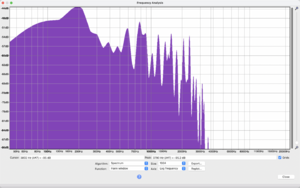Course:PHYS341/2022/Project15
The Electric Guitar Tonewood Debate
There is a longstanding debate in the guitar world concerning whether or not the type of wood used in the guitar’s construction affects the guitar’s timbre when it is plugged in. Traditional wisdom dictates that each of the most popularly used woods make distinct identifiable contributions to the overall tone. Among fretboard materials, rosewood is warm and maple is snappy. For the body, mahogany is more mellow and ash is brighter. Players can hear for themselves that guitars differ from each other, even between two of a kind, and the general consensus is that the differences between these different tonewoods is also indeed discernable if only one’s ear is keen enough.
However, this is contested on the grounds that these notions are fallaciously carried over from the construction of acoustic guitars. Skeptics claim that, while the sound of an acoustic guitar depends heavily on the types of wood used, and that while this even holds true for the acoustic sound of an electric guitar, the tone of a plugged-in electric guitar is almost completely dependent on the pickups and electronics.
Against this context, the tonewood debate becomes a matter of each side offering differing physics accounts of the role tonewoods play in the final sound.
The Argument Against Tonewoods
As conceived by opponents of tonewood, the account of the sound of a plugged-in electric guitar goes as follows: The vibrations of the strings are picked up by electromagnetic transducers (i.e.the pickups) and then transmitted as electric signals through the cabling into the amplifier.
The fact that the electromagnetic transducers are not sensitive to picking up the vibrations of the body means that electric guitars can be constructed with radical body designs, such as ones made of acrylic, cardboard, and concrete, or ones with holes drilled all through them, or ones with nearly no body mass at all, and that differences in tone can ultimately not even be noticeable to experienced players in a blindfold test. The myth of tonewoods is perpetuated by illusory anecdotal evidence and industry marketing, and this confusion is further exacerbated by the fact that the term “tonewood” is a misappropriation of acoustic guitar-making terminology originally simply meant to refer to woods that would emit a more bell-like sound when struck, rather than a term for any wood used in the construction of an electric guitar implying that they each hold unique tone properties.
The Argument For Tonewoods
Defenders of tonewoods concede that pickups are picking up the vibrations of the strings, but counter that ultimately the vibrations of the strings are subject to interaction with the vibrations of the guitar at the two contact points at either end of the strings. Because of this, the way the body of the guitar is vibrating, along with the nut, the neck-joint, and even the string angles meeting the headstock, among numerous other factors, all contribute to the vibrations being picked up. In this way, the properties of different woods do make a discernible difference to the tone of a plugged-in electric guitar.
Conclusive Evidence
Far fewer empirical studies exist investigating the generation of sound in electric guitars compared to acoustic instruments. One recent study from Poland found noticeable differences in spectral analyses of guitars constructed of various exotic tonewoods (Jasinski et al, 2021). Another group of researchers demarcated the different properties of walnut and ash wood that would contribute to different tones, and they identified "the larger modulus of elasticity and shear modules in all anatomical directions and planes," damping effects, and string energy transfer among others (Zoric et al, 2019). These findings suggest tonewoods make a difference, but more work is needed to be conclusive.
Example Experiment
This experiment shows the frequency response of an electric guitar. The electric guitar was played through an amplifier to show the frequencies that are being picked up by the guitar’s pickups. The aim of the experiment was to determine if the frequencies that are present in the strings are affected by the resonance characteristics of the guitar’s body. The control was an Open G chord being strummed once and left to decay naturally. The variable was an Open G chord being strummed once and left to decay naturally, but with a piece of 45cm x 45cm and 2cm thick foam pressed tightly against the back of the body.
Control
The control for this experiment was an Open G chord being strummed and left to decay.

Guitar with Foam

This attempt was an Open G chord being strummed and left to decay while the piece of foam was pressed tightly to the back of the guitar’s body.
Results
The spectrum graphs show that the piece of foam had an effect on the frequencies that were being picked up by the guitar’s pickups and sent through the amplifier. In particular, the response is different at approximately 950 Hz and in between 3000 Hz and 4000 Hz. This shows that the body’s resonance affects the frequencies that are picked up by the pickups.